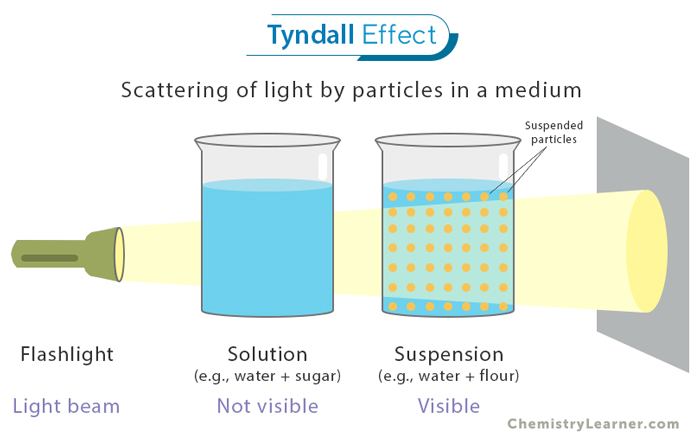Tyndall Effect
The Tyndall Effect is a fascinating optical phenomenon that occurs when tiny particles scatter light in a medium. It can be understood as the interaction between light and matter on a microscopic scale. When a beam of light encounters particles or molecules in a medium, the individual photons interact with these particles, causing them to scatter in various directions [1-4].
The Tyndall Effect is particularly pronounced when the size of the particles or molecules in the medium is comparable to the wavelength of light. It is because when the particles are of similar dimensions to the wavelength of the incident light, they effectively “interact” with the light and significantly scatter it in all directions. Consequently, the scattered light becomes visible to an observer.
This optical phenomenon is named after Irish physicist John Tyndall, whose experiments in the mid-19th century played a pivotal role in elucidating it.
Examples
Understanding the Tyndall Effect is best achieved through real-world examples where it plays a crucial role in our daily lives and observations. Here are some instances where this effect is prominent [1-4].
Natural Examples
1. Earth’s Atmosphere
Sunlight, which appears white, is composed of a spectrum of colors. When sunlight enters the Earth’s atmosphere, shorter blue wavelengths scatter more effectively. This scattering is responsible for the blue appearance of the sky during the day.
2. Ocean Waters
Water molecules scatter sunlight in a way similar to the sky. They cause the water to absorb longer wavelengths, such as red and yellow. In contrast, the shorter blue wavelengths are scattered and reflected, resulting in the characteristic blue hue of oceans.
3. Fog and Mist
Tiny water droplets or ice crystals suspended in the air scatter light, making fog and mist appear white or hazy. The Tyndall Effect reduces visibility in foggy conditions, especially when driving.
Everyday Life Examples
1. Milk
Tyndall Effect can be observed at home when shining a flashlight through a glass of milk. The proteins and fat molecules in milk are larger than wavelengths of visible light, causing them to scatter light, making the milk appear opaque and white.
2. Headlights
Xenon or LED headlights produce a beam of intense white light. When this light passes through the gases in the headlight bulb, it scatters and produces a visible beam that can illuminate the road ahead effectively. The scattering of light also helps oncoming drivers see the vehicle’s headlights more clearly.
3. Eye Color
The color of the human eye is determined by the scattering of light within the iris. The iris contains various layers of melanin-containing cells. Melanin is the pigment responsible for the coloration of various parts of the body, including the skin, hair, and eyes.
Brown eyes have a higher concentration of melanin in the iris, which absorbs more light and scatters less. In the case of blue eyes, there is less melanin, particularly in the front layers of the iris. This lack of melanin allows for more light scattering within the iris, which produces a blue appearance.
References
- Tyndall Effect – Chem.libretexts.org
- Tyndall Effect: Definition and Examples – Thoughtco.com
- Tyndall Effect – Chemistrytalk.org
- Tyndall Effect – Chm.bris.ac.uk





